Brother MFC-J6710DW Review
Brother MFC-J6710DW
Brother’s MFC-J6710DW adds several useful extras to its big-page A3 duplex print and simplex scan and copy.
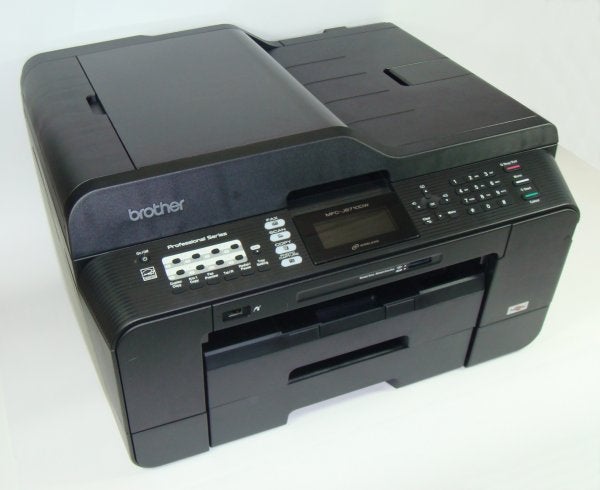
Verdict
Pros
- A3 Automatic Document Feeder
- Memory card and PictBridge sockets
- Quick, front-access ink cartridges
Cons
- Odd paper tray restrictions
- Slow A3 print with ‘drying time’
- Simplex scanner
Key Specifications
- Review Price: £250.00
- A3 print, scan and copy
- Wireless connection
- Twin paper trays
- Widescreen LCD display
- Full fax functionality
Brother is really the only manufacturer to take office A3 print seriously. While other makers have token A3 all-in-ones in their ranges, Brother has a complete range and a commitment to update them, with the MFC-J6710DW set roughly in the middle.
Still looking something like a flying machine out of Tron (the original 1982 version), this large footprint printer is a wonder of the plastic moulder’s art. Large areas of high-gloss and textured black plastic make up its casing, with the two combining into a pinstripe-effect finish, covering the full-width control panel.
The panel has a click-up, widescreen LCD display at its centre, bordered to the left by mode keys, 16 quick-dial buttons and a series of option keys; and to the right by a navigation diamond, fax number pad, plus Start and Stop buttons.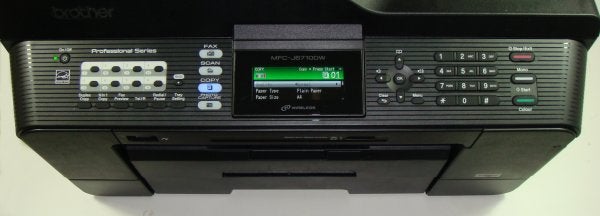
Above the control panel is a 35-sheet, full A3 Automatic Document Feeder (ADF) with a flip-over cover, which becomes the feed tray, and a pop-up end stop, to catch scanned pages. In front of the control panel are sockets for USB/PictBridge and for SD and MemoryStick cards.
Brother’s MFC-J6710DW comes as standard with two, 250-sheet paper trays and the top one has a pull-out and flip-up support for printed pages. Both trays are capable of taking paper up to A3, but only the top one can take sheets down to 15 x 10cm. Also, it doesn’t appear you can feed normal inkjet paper from the lower tray. There’s a further straight-through paper path from a flip-open cover at the back.
The printer can be connected via USB and Ethernet, though you have to reeve the cables through into the heart of the machine to reach the sockets. Much easier to connect it wirelessly, using the easy to set up WPS-compatible wizard built into the machine.
Cartridge installation is very straightforward, thanks to the printer’s piezoelectric printheads and remote cartridges, which slide in behind a cover to the right of the paper trays. Software installation is also simple and includes Nuance PaperPort, as well as Brother’s own MFL-Pro Suite.
The rated speeds for the Brother MFC-J6710DW are 12ppm for black print and 10ppm for colour. We think these are optimistic, but if you take off the housekeeping that happens before prints start, you might get somewhere near. Our five-page black text print gave 6.5ppm and this rose to 9.7ppm in draft mode.
On the 20-page document, the machine ran at 9.0ppm and printing duplex it still managed 3.8 sides per minute. Printing our black text and colour graphics test produced 4.8ppm on A4 paper but only 1.4ppm on A3. This is largely due to the amount of preparation time and 14s of ‘drying’ time added before starting every sheet.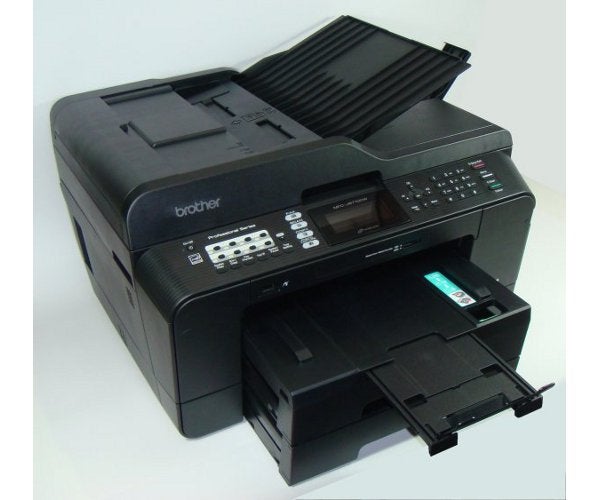
This is slightly bizarre, as we’re talking single-sided print and there’s no real reason why an A3 page shouldn’t dry as quickly as an A4 one, where the mandatory drying time isn’t invoked. Also, if you use inkjet paper, which isn’t as absorbent as most plain papers, there’s no extra drying time for either size.
When it comes to copies, the machine is quite speedy, producing five A4 pages from its ADF in 1:17 and five A3 pages in 2:17. 15 x 10cm photos took between 1:15 and 2:03 and a full A3 photo completed in 3:37.
Print quality from the Brother MFC-J6710DW is a bit of a mix. Black text is reasonably clean, though there is fuzziness around many characters, if you look at all closely. Colour graphics are reasonably bright and dither patterns in colour fills are not too noticeable.
However, colour copies came through very pale in our tests and some photo prints were uncharacteristically blotchy, even on Brother’s own BP71 photo paper. We haven’t seen this before, so suspect it’s an isolated example.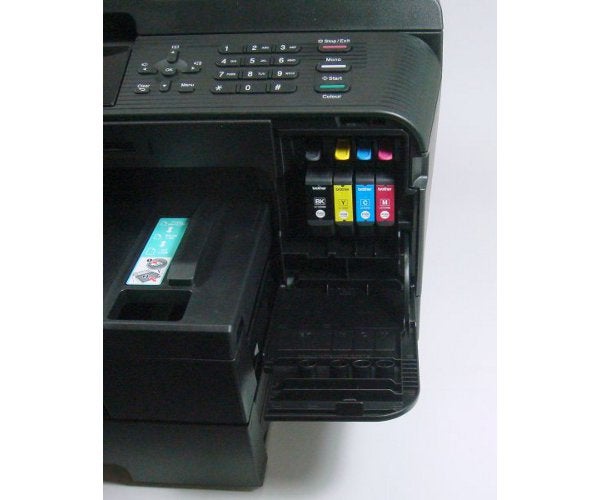
The four ink cartridges are available in two capacities and using the higher yield components gives page costs of 1.8p for black and 5.3p per colour. These are both pretty good for an inkjet device at this price and with a relatively high capacity for an inkjet printer, you shouldn’t be having to attend to them every week.
Verdict
Brother’s MFC-J6710DW is, in our opinion, slightly better value than the models directly above and below it in the company’s range. It has three different paper sources, can handle duplex print up to A3 and has easy wireless setup. While the paper feed idiosyncrasies are annoying and the photo output was variable on this sample, overall it’s a reasonable choice for a large format, small business all-in-one.
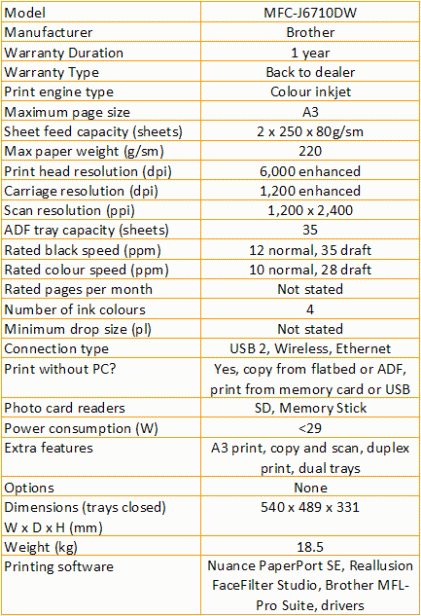
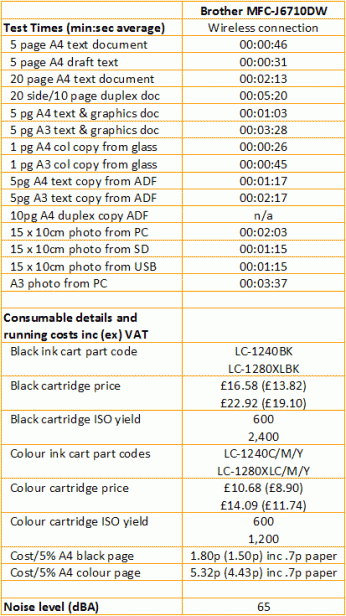
Trusted Score
Score in detail
-
Print Speed 7
-
Features 9
-
Value 7
-
Print Quality 5
Features
| Networking | Yes |
| Card slot | SD, MemoryStick |
| Connection Type | Ethernet, USB |
| Extra Features | A3 print, copy and scan, duplex print, dual trays |
Physical Specifications
| Height (Millimeter) | 331mm |
| Width (Millimeter) | 540mm |
| Depth (Millimeter) | 489mm |
| Weight (Gram) | 18500g |
Printing
| Type | Inkjet |
| Duplex | Yes |
| Paper Size | A3 |
| Colour | Yes |
| Number of Catridges | 4 |
| Sheet Capacity | 2 x 250 sheet trays |
| Print Resolution (Dots per inch) | (enhanced) 6000 x 1200dpi |
| Rated Black Speed (Images per minute) | 12ipm |
| Rated Colour Speed (Images per minute) | 10ipm |
| Max Paper Weight | 220g/sm |
| Print Without PC | Yes |
Functions
| Scanner | Yes |
| Copier | Yes |
| Fax | Yes |
Scanning
| Scan Resolution (Dots per inch) | 1200 x 2400dpi |

